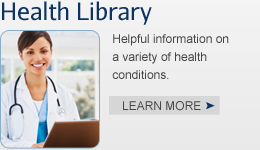Health Library
Our Health Library information does not replace the advice of a doctor. Please be advised that this information is made available to assist our patients to learn more about their health. Our providers may not see and/or treat all topics found herein.
Food Safety: Cooking
Overview
It is important to cook foods well and at a safe temperature to prevent food poisoning. Here are a few tips.
- Use a clean meat thermometer.
It can show whether meat, poultry, or egg dishes are cooked to a safe temperature.
- Bring liquids to a boil when reheating.
Bring sauces, gravies, and soups to a boil when reheating. Reheat other leftovers to at least 165°F (74°C).
- Heat food well in the microwave.
When using a microwave, cover the food container, and turn or stir the food to make sure it is heated evenly throughout. If the microwave does not have a turntable, rotate the dish by hand once or twice during cooking.
- Cook eggs well.
Cook eggs until whites and yolks are firm.
- Avoid eating raw or undercooked foods.
Do not eat raw or partially cooked eggs (including cookie dough), raw (unpasteurized) milk, cheeses made with raw milk, or unpasteurized juices.
- Cook meat to a safe temperature.
Do not eat undercooked hamburger, the main source of E. coli infection. Cook fish and shellfish until it is opaque and flakes easily with a fork. Be aware of the risk of food poisoning from raw fish (including sushi), clams, and oysters.
- Be careful when eating out.
Make sure foods are thoroughly cooked and are served hot.
Credits
Current as of: October 24, 2024
Current as of: October 24, 2024


